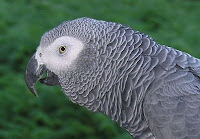The African Grey Parrot
 |
| African Gray Parrot |
The African gray parrots are considered among the most intelligent of birds. Several sub-species of this very loveable birds have been identified, but it is only the Congo African Grey Parrot or CAG (Psittacus erithacus erithacus) and the smaller Timneh African Grey Parrot or TAG (Psittacus erithacus timneh) that are universally recognized as Gray Parrots. Grey parrots habitat, range from Kenya, Tanzania, Uganda, Angola all the way to Ivory Coast, Sao Tome and Principe in Western Africa. As about one-fifth of these birds are poached from the wild to be sold as pets and as the parrot's habitats are being fast destroyed - the parrots' population is in decline; it will not be long before these wonderful birds are on the critically endangered list of animals.
In East Africa, grey parrots can be found in Uganda: South-Western Uganda, Murchison Falls Protected Area, around Mabira Forest, probably in Sesse Islands and at the Entebbe Wildlife Education Center; with luck, you may see these birds, in Kampala, flying in the mornings and evenings to and from roost. In Kenya, grey parrots can be found in the western part, mainly in Kakamega Forest. And in Tanzania, the North-West is the best place to sight grey parrots. Very few of these monogamous birds are kept as pets here in East Africa; mainly by the affluent. Without their natural habitat, gray parrots very rarely breed. It is not easy to see them in the wild and you need a very knowledgeable guide for you to see them in their natural habitats.
+ IUCN
+ CITES
+ Arkive
+ World Parrot Trust
+ Books


